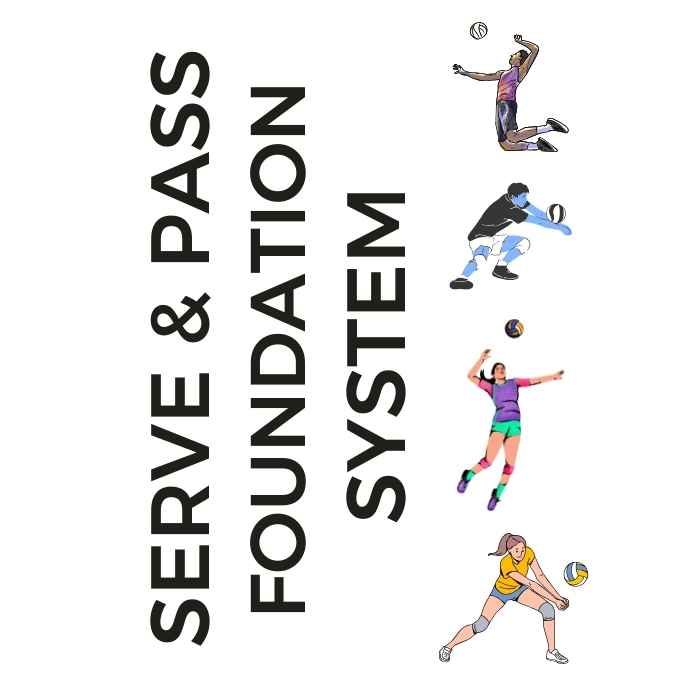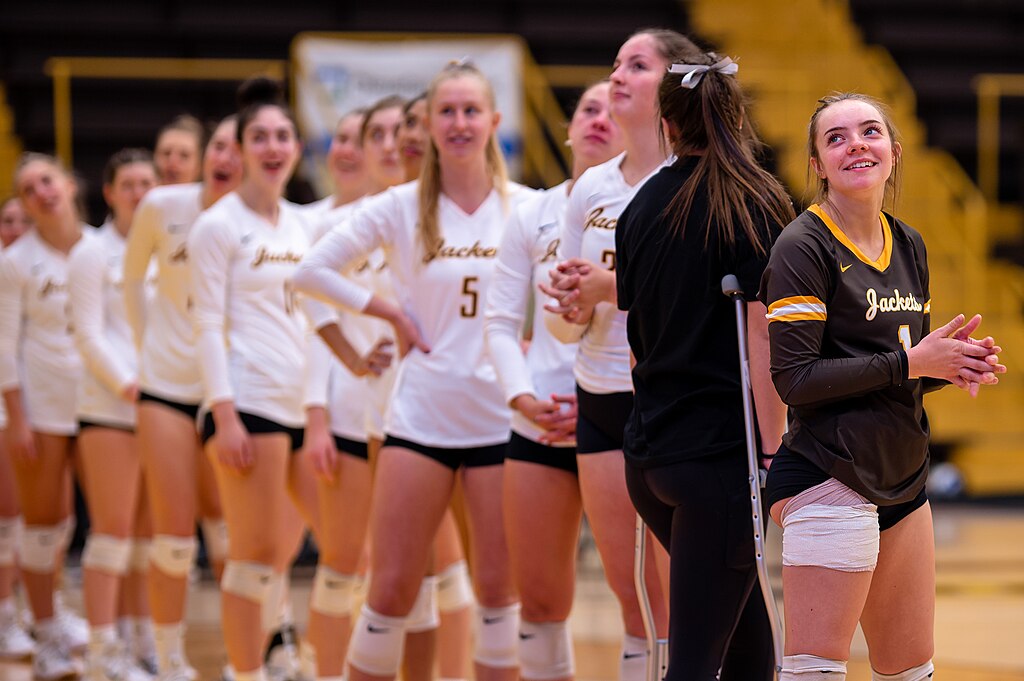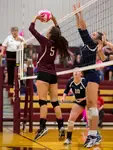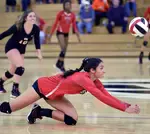
Serve + Pass Foundation System: The Complete Skills Arsenal The two-skill mastery system that transforms inconsistent players into the athletes coaches build their lineups around. Stop Struggling With The Two Most Important Skills In Volleyball!
- Improve Your Volleyball with Coach April
- Mom's Guide To Volleyball Setting Technique
- On-Court Volleyball Communication
Volleyball Moms Learn The Lingo Of On-Court Volleyball Communication
Unlock the secret language of on-court volleyball communication by liberos and backrow players, boost your volleyball IQ and support your player's growth.
Today, I want to speak to the moms of young liberos, future defensive specialists and up-and-coming back court players who have to learn on-court volleyball communication that defensive players speak and use among themselves and to the hitters that they support in the front row.
If your athlete struggles with consistent serve receive, gets subbed out, or is overlooked for playing time—this is the fix you’ve been looking for.

Struggling with passing consistency?
I help talented passers tired of getting pulled from games because of inconsistent serve receive skills BUILD passing confidence without expensive private lessons using the same 3-step system that's helped dozens of my athletes get recruited.
Download my eBook for $17.99 and start building the passing confidence that keeps you on the court—and gets you seen by college coaches.
As a volleyball mom, understanding the unique language of the defensive specialist position can help you better support your player, regardless of their age or skill level.
Whether you're cheering on a budding tween player, encouraging a teenage intermediate player on the JV team, or supporting a varsity starter, this guide will boost your volleyball IQ and make you an invaluable resource for your athlete.
Who're The Types of Players That Speak On-Court Language
- The Back-row player:
The backrow player is substituted into or rotates back to the Zone 1 position to serve, then stays only in the backrow to pass and play defense in Zone 6 and Zone 5 before being substituted out to be replaced by a front row player.
Liberos and six rotation players as well as defensive specialists are also called backrow players.
- The Defensive Specialist:
A defensive specialist has the same responsibilities that a libero has with these exceptions
- wears the same colored jersey as everyone else on the team
- can jump and hit the ball when its above the level of the net - (a libero cannot)
Libero-Setter Synergy: The Key To Offensive Flow With On-Court Volleyball Communication
The communication between a libero (the backrow quarterback) and setter (the front row quarterback) is important for a volleyball team's success.
This libero setter on-court volleyball communication often involves specific terms to provide each other feedback on the quality of each pass and the options for offensive strategies.
- "Perfect" or "Good"
The feedback a setter communicates to a passer, like a libero, to let them know that "that' pass was good enough for them to run the offense the way they need to run it ...making it easy for the setter to get to the ball
A pass that's right on target, also called "an in-system" pass, allowing the setter multiple offensive options.
- "Off":
The feedback a passer communicates to the setter when they know they just passed a ball that's "off the net" alerting the setter that they'll have to move to position themselves to a ball that's not coming right to them.
- "Help":
The feedback a passer who completed a pass that's not going right to the setter, possibly a shanked ball, alerting her/his teammates that someone is going to have to scramble to get the mis-passed ball that is not going to the setter so someone needs to step in and "help" the setter get to the second ball
In other words this is a call for assistance when the setter in the front row or the libero or a back court player in the backrow is out of position and struggling to reach the ball.
Mom Tip:
Encourage your player to build trust and rapport with their setter through consistent volleyball communication. The stronger their connection, the smoother the offense will flow.
Reading the Game: How Liberos Use On-Court Volleyball Communication To Preview Opponent Strategies
Liberos are like the quarterbacks of volleyball defense. Their libero defensive volleyball communication helps the entire team adjust to the opponent's tactics:
Volleyball Digging Drills: Cross Court Digging Reps in Breakfast Club Warmups with Coach April
- "Line" or "Cross":
These calls are
- made by the passers to each other
- in order to communicate to each other in serve receive
- where they expect a serve (or a hit) to land in their court
- before it crosses the net
- which is a way teammates help teammates decide where to position themselves
- "Deep" or "Short":
Same as above but used to describe the depth (how deep in the court or how close to the ten foot line) they think an opponent's serve will land, with the intention of helping teammates adjust their serve receive formation accordingly.
Passing the deep serve consistently requires teammates to talk to each other to let each other know who is going to move deep in the court to pass the deep serve.
- "Seam":
A call that alerts teammates in serve receive that an opposing server could possibly serving a ball to a seam in the court which is the space between two passers.
A seam is also the space between two blockers going up together to stop a hitter's spike attack
Its a ball that's usually passed over the net making it easier to get to and run a counterattack with
Mom Tip:
Watch high-level volleyball matches with your player and focus on the libero's defensive volleyball communication. Discuss how they read the game and relay information to their teammates.
Silent Signals: Mastering Non-Verbal Libero Volleyball Communication
Not all volleyball communication is vocal. Setters are the offensive quarterbacks that use a lot of non-verbal cues to call offensive plays and strategies.
Hands Signals For Setters in Volleyball
Liberos use a variety of hand signals to indicate serve receive formations or defensive adjustments.
These can range from simple finger counts to more complex gestures.
- Body Positioning:
The way a passer positions themselves on the court can communicate volumes to their teammates. A slight shift can indicate where they expect the ball to go.
- Eye Contact:
A quick glance between a libero and their teammates can confirm assignments or signal a change in strategy.
Mom Tip:
Encourage your player to practice non-verbal libero volleyball communication during drills. Have them focus on clear hand signals and purposeful body positioning.
Beyond Words: The Art of Emotional On-Court Volleyball Communication
Effective on-court volleyball communication isn't just about words or signals; it's also about attitude and energy:
- Positive Body Language:
A libero's confident posture can inspire the entire team.
- Enthusiasm:
Celebrating great plays (even small ones) can boost team morale.
Most teams after each play will come to the middle of their court and clap or say something before going back to their base position in serve receive or in defense
- Composure:
Staying calm under pressure communicates strength to teammates.
Mom Tip:
Remind your player that their attitude and emotional volleyball communication can have a big impact on team morale. Encourage them to stay positive and supportive, even in tough situations.
From Beginner to Pro: Evolving Volleyball Communication Skills with Your Player
As players progress from youth leagues to high school and potentially college, their volleyball communication skills will need to evolve:
- Youth:
Focus on basic calls and positive encouragement.
- High School:
Introduce more complex defensive communication and non-verbal cues.
- College:
Master and memorize advanced strategy communication and leadership skills.
Mom Tip:
Make volleyball communication skills a priority in your player's training. The better they can communicate on the court, the more effective they'll be as a teammate and leader.
To Finish Things Up
As a volleyball mom, your support and encouragement can make a big difference in your child's communication development.
By understanding these aspects of on-court volleyball communication, you're not just helping your player become a better defender – you're supporting their growth as a leader, team player, and effective communicator both on and off the court.
Remember, the skills your child develops through volleyball communication – clear expression, quick thinking, and teamwork – will serve them well in all aspects of life.
So keep practicing, keep encouraging, and watch with pride as your libero becomes a master communicator!
Do You Follow Me on Pinterest?
 Private or semiprivate volleyball indoor/sand lessons are an excellent way for young Las Vegas high school volleyball players to quickly improve their individual skills through a private or semi-private coaching experience.
These lessons are conducted by former pro volleyball player, former USA Volleyball High Performance instructor and Evaluator and Tstreet Vegas 18s head Coach April Chapple on a weekly basis.
Sign up now!
Private or semiprivate volleyball indoor/sand lessons are an excellent way for young Las Vegas high school volleyball players to quickly improve their individual skills through a private or semi-private coaching experience.
These lessons are conducted by former pro volleyball player, former USA Volleyball High Performance instructor and Evaluator and Tstreet Vegas 18s head Coach April Chapple on a weekly basis.
Sign up now!Follow me on Pinterest Volleybragswag to improve your game even faster!
I share alot of individual, partner and easy-to-do volleyball serving drills we do in class with my followers.
Many of these volleyball practice drills you can do at home by yourself or try at your next practice with your teammates.
If you're a B team or JV player trying to make varsity next year...your goal should be to complete 1000 reps a day of at least three of the basic skills on your own...volleyball passing, serving and setting should be at the top of the list.
From Lady Vol to Legend: Coach April Produces Powerful Passionate Players...is that you?
What Are You Looking For?
Click to Download Your Pre Serving Ritual Mastery Checklist pdf:
🎯Volleyball Pre Serving Ritual Guide -
Players! Learn How To Transform Your Serve from Weak to Weapon
Click to Download Your Parent's Volleyball Serving Checklist pdf
🎯Parent's Volleyball Serving Checklist Guide
Parents! Help Your Player Develop Championship Serves (Even If You've Never Played)

Hi there!
Thanks for stopping by. Hope you learned something today that will help you reach your volleyball goals.
Be sure to subscribe to my email newsletter so you can learn more each week!
Stay strong! Stay motivated!
-Coach April

SUSCRIBE to my email newsletter below!
 Click to learn more about the weekly volleyball classes and clinics or email info@imrpoveyourvolley.com for information
Click to learn more about the weekly volleyball classes and clinics or email info@imrpoveyourvolley.com for informationCongratulations to my seven Boys-18s Vegas Volley club players who played in two state championship finals yesterday, the 3A and 5A State champinship finals at Sunrise Mountain High School.
TOURNAMENT CHAMPIONS!
A-1 Vegas Volley VBC
In It To Win It Tournament
May 2 - 4, 2025 Tournament
Gold Medalists
18s Premier Division
Vegas Volleyball's Unsung Heroes: Celebrating Moms with Peace Love Volleyball Shirts
Ready to energize your volleyball mom journey?
Subscribe to my 'Producing Powerful Passionate Peaceful Players' email list above on ImproveYourVolley.com.
You'll receive energy-boosting tips, exclusive insights from me, Coach April Chapple on maintaining momentum in volleyball.
Let's power up the Vegas volleyball scene together!
Recent Articles
-
6 Volleyball Setting Checklists For Players With College Prep Goals
Dec 24, 25 06:18 PM
6 volleyball setting checklists that build elite setters. Master hand positioning, footwork, set types, back setting & jump setting. Includes at-home drills. -
The Volleyball Checklist: Skill Development Systems That Get Results
Dec 24, 25 02:22 AM
Master serving, passing and other basic skills with a step-by-step volleyball checklist from a Tennessee Hall of Famer who trains college-recruited athletes. -
How To Set A Volleyball A Basic Setter Guide To Good Setting Technique
Dec 24, 25 02:07 AM
Want to be a good volleyball setter? I show you how to set a volleyball the way I teach my club players, focusing on hand and body placement and ball contact.

















































